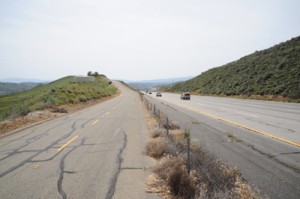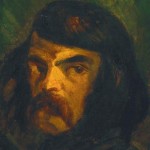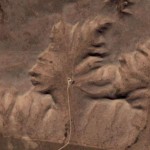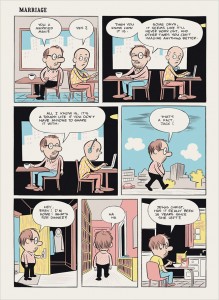“Ghost towns are fascinating places because they allow visitors to transport themselves, in their imaginations, to past times and places. Ghost roads are not as well known. But they do something similar to their more marketable counterparts, and, in a sense, even better. Ghost roads take us to places that were designed, constructed and maintained with the sole purpose of being passed through — the more swiftly and safely the better. Even as ruins, they fulfill their original purposes, often in ways their makers never intended. That’s exactly what the staff of the Center for Land Use Interpretation does in its readily accessible presentations: get visitors to see what exists in the world in ways that make everything about it more interesting. “Through the Grapevine: Streams of Transit in Southern California’s Great Pass” takes the standard format of image-and-text Conceptualism and turns it into a moving journey through the history of the roadways, aqueducts, pipelines and electrical lines that have been built through the Grapevine throughout the 20th century….”
Read More: Through the Grapevine’ at the Center for Land Use Interpretation
“A picture in London’s National Gallery, which was once attributed to Delacroix, could be a “fake” painted by Sickert. Originally dated to 1830-50, it might have been created by Sickert in an audacious move to fool the curators. Portrait of a Man is to go on show in “Close Examination: Fakes, Mistakes and Discoveries”, 30 June-12 September. Walter Sickert (1860-1942) donated the portrait to the Tate in November 1922 and in 1956 it was transferred to the National Gallery. In 1922 the painting was attributed to Eugène Delacroix (1798-1863) and the sitter was recorded as the French social reformer Victor Considérant (1808-93). However, the sketchy portrait bears little resemblance to Considérant, and although in Delacroix’s style, it was later downgraded as not by the master…”
Read More: “Fake Delacroix” could be by Sickert

How To Wreck A Nice Beach Vocoder Playlist
(:01) On the Beach—Neil Young
Twenty years ago, I “fell asleep” on Figure 8 Island wearing a Public Enemy hat. It had been given to me by Terminator X. When I woke in the morning, I was wearing a G N’ R hat. Two crossed pistols, a skull, and roses. Whatever maniac did this: Please return my PE hat. No questions asked.
(:12) EMS Vocoder Test (1976)
I was told this is an impression of Grover talking about the pyramids.
(:31) The Bells of St. Mary’s Condition—Bell Labs (1936)
“The true loves who come from the sea…”
The Bell Labs referred to their vocoder tests as conditions. All Bell Labs conditions here were acquired from the Werner Meyer-Eppler archives at the Institut Phonetik at Bonn, not Bell Labs. W.M.E. referred to the vocoder as a retro-transformer, thirty years before a Decepticon showed up in a Trouble Funk song.
(1:16) The Unvoiced Hiss Energy Condition—Bell Labs (1936)
Pass the conch like they used to say.
(1:32) Change the Beat—Beside & Fab Five Freddy (1982)
“If we were any fresher you’d have to slap us.”
—Fresh Market billboard, Greenville, S.C.
(1:40) Pak Man (intro)—Jonzun Crew (1983)
A song about one man’s desire to exterminate all Pac Man machines with the help of a device invented to rewire the chromatic spectrum of the universe using 17 million colors, the Suboptic Shadow World, and Sun Ra.
Hear More [and download]: How To Wreck A Nice Beach
“Located in southeastern Alberta, Canada near Medicine Hat, this great geological wonder can only be seen from high above the ground. Nevertheless, its humanoid details are stunning when one considers that human hands did not take part in shaping this large mass of rock. Viewed from the air, the feature bears a strong resemblance to a human head wearing a full First Nations headdress. Because of additional man-made structures, it also appears to be wearing earphones. The profile was formed by the erosion of rainwater on layers of clay-rich soil. The headphone’s wires are formed by a dirt road, and the earpiece is formed by an oil well where the road ends. However, these additional man-made details only add an interesting touch; they are not absolutely necessary to give identity to the figure…”
Read More: The Badlands Guardian
“Say hello to Wilson, the eponymous hero of Daniel Clowes’s latest novel-in-comics. Perhaps he is a hero of our time. But if that phrase makes all you comp-lit majors think of Lermontov’s Pechorin, think again: this haggard, middle-aged fellow is no dashingly depressive duelist or seducer. Wilson hectors people in coffee shops and hits on his ex-wife with sweet nothings like, “As you know, I certainly never minded a larger woman.”
“He is a rich mix of states and traits: lonely, alienated, obsessed with his dog and the mistakes of his past, unjustifiably smug, genuinely funny, nettlesome, underhanded, empathetic and always all too human. Does he stand for a generation, like Pechorin? No, he stands for Wilson — a glorious swirl of confusion, hypocrisy and simple yearning. Wilson may seem like an everyman, but he is soaked in idiosyncrasy, and not necessarily the kind that leads to some imagined universal. Instead we get a flawed and conflicted individual, whose laments, even when tainted by ego, or maybe especially when tainted by ego, are deeply affecting.
“The Daniel Clowes aesthetic, delivered through his numerous comics, album covers, book illustrations and film work, has made a distinctive impression on the culture. Ever since his “Eightball” comics in the early 1990s and up through “Ghost World” and “David Boring,” he has fashioned a singular style both from the drabness of America’s midsize cities and towns and from the vital tradition of telling stories in panels, with pictures and words…”
[Click to enlarge image]




